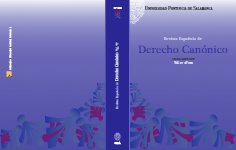Prima del 1054: centri e periferie, universitalitá e particolaritá nel diritto della chiesa al tempo di San Simeone di Siracusa Treviri (1035)
Contenido principal del artículo
San Simeone fu un monaco bizantino di origine siciliana che concluse la propria vita a Treviri, dove la sua memoria è venerata dall’anno della sua morte (1035). La storia della sua vita mostra l’intensità dei processi di comunicazione tra la Chiesa latina e la Chiesa bizantina agli inizi del secolo XI, ed è presa come il punto di inizio di uno studio sulla configurazione del sistema giuridico della Chiesa latina tra la fine del primo Millennio e i primi decenni del secondo. La ricerca concentra quindi l’attenzione sull’esperienza istituzionale della «Chiesa imperiale», articolata intorno ai due poli dell’impero e del papato. L’ideale ecclesiologico e politico di collaborazione fra potere civile e potere ecclesiastico trovò esplicazione nelle iniziative di riforma ecclesiastica promosse da imperatori come Enrico II ed Enrico III e sostenute da alcuni fra i migliori Pontefici della prima metà del secolo XI. Alcune collezioni canoniche della prima metà del secolo XI si impegnarono nello sforzo di selezionare e coordinare le fonti del diritto canonico al fine di assecondare i propositi di riforma della vita ecclesiale.
Detalles del artículo
Cómo citar
Citas
--

